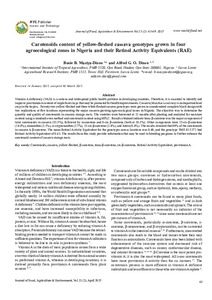| dc.contributor.author | Maziya-Dixon, B.B. |
| dc.contributor.author | Dixon, Alfred G.O. |
| dc.date.accessioned | 2019-12-04T10:57:22Z |
| dc.date.available | 2019-12-04T10:57:22Z |
| dc.date.issued | 2015-03-30 |
| dc.identifier.citation | Maziya-Dixon, B.B. and Dixon, A.G.O. (2015). Carotenoids content of yellow-fleshed cassava genotypes grown in four agroecological zones in Nigeria and their Retinol Activity Equivalents (RAE). Journal of Food, Agriculture & Environment, 13(2), 63-69 |
| dc.identifier.issn | 1459-0255 |
| dc.identifier.uri | https://hdl.handle.net/20.500.12478/714 |
| dc.description.abstract | Vitamin A deficiency (VAD) is a serious and widespread public health problem in developing countries. Therefore, it is essential to identify and
improve provitamin A content of staple food crops that may be promoted for health improvements. Cassava (Manihot esculenta) is an important food
crop in the tropics. Twenty-two yellow-fleshed and three white-fleshed cassava genotypes were grown in a randomized complete block design with
two replications at five locations representing the major cassava-growing agro-ecological zones in Nigeria. The objective was to determine the
quantity and quality of carotenoids in cassava storage roots. The varieties were harvested at 12 months after planting and analyzed for moisture
content using a standard oven method and carotenoid content using HPLC. Results obtained indicate trans β-carotene was the major component of
total carotenoids in cassava (53.5%), followed by α-carotene and 9-cis β-carotene (both at 19.3%). Other components were 15-cis β-carotene
(14.9%), zeaxanthin (3.1%), α-cryptoxanthin (2.7%), 13-cis β-carotene (2.4%), and lutein (0.4%). The results revealed that 90% of the carotenoids
in cassava is β-carotene. The mean Retinol Activity Equivalent for the genotypes across locations was 0.40, and the genotype TMS 01/1371 had
Retinol Activity Equivalent of 0.63. The results from this study provide information that may be used in breeding programs to further enhance the
carotenoid content of cassava storage roots. |
| dc.format.extent | 63 - 69 |
| dc.language.iso | en |
| dc.subject | Cartenoids |
| dc.subject | Cassava |
| dc.title | Carotenoids content of yellow-fleshed cassava genotypes grown in four agroecological zones in Nigeria and their Retinol Activity Equivalents (RAE) |
| dc.type | Journal Article |
| dc.description.version | Peer Review |
| cg.contributor.crp | Roots, Tubers and Bananas |
| cg.contributor.affiliation | International Institute of Tropical Agriculture |
| cg.contributor.affiliation | Sierra Leone Agricultural Research Institute |
| cg.coverage.region | Africa South Of Sahara |
| cg.coverage.country | Nigeria |
| cg.identifier.url | http://world-food.net/carotenoids-content-of-yellow-fleshed-cassava-genotypes-grown-in-fouragroecological-zones-in-nigeria-and-their-retinol-activity-equivalents-rae/ |
| cg.authorship.types | CGIAR and developing country institute |
| cg.iitasubject | Cassava |
| cg.iitasubject | Research Method |
| cg.journal | Journal of Food, Agriculture & Environment. |
| cg.howpublished | Formally Published |
| cg.accessibilitystatus | Limited Access |
| local.dspaceid | 70331 |
| cg.targetaudience | Scientists |

